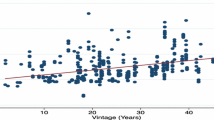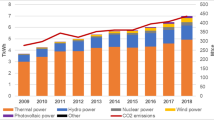Abstract
This article examines the thermal power generation efficiency of ten Japanese electric power companies and the shadow prices of carbon dioxide (CO2) by employing a directional output distance function (DODF) with panel data for 1990–2011. We find that the shadow price of CO2 varies greatly between US$1.49 and US$288.82, depending on the company’s production strategy concerning energy supply and CO2 emissions. These shadow prices give us clues to understand how the electric power companies may respond to environmental regulations, such as environmental tax and emission trading systems. According to the DODF, an additional 53571 GWh of electricity could have been generated in 2011 at the cost of an increase of 40105 thousand tonnes of CO2, if the companies would have operated efficiently giving little consideration to CO2 emissions reduction. These increases are equivalent to 8.77 and 9.18 % of total electricity and CO2 emissions, respectively, from the ten electric power companies in 2011. On the other hand, if the companies would have operated efficiently and given first priority to CO2 emissions reduction, a further 58002 thousand tonnes of CO2, equivalent to 13.28 % of their total CO2 emissions in 2011, could have been reduced as a whole.


Similar content being viewed by others
Notes
It should be noted that while nuclear power generation does not generate CO2 in the process of generating electricity, it produces radioactive waste, which causes other grave environmental and health-related issues.
Exchange rate = ¥100 per US$1.
The introduction of an environmental tax was under discussion since 2004. According to the Ministry of the Environment (2011b), the originally planned tax rate was US$6.6 per tCO2.
The term \( - qy_{2} \) represents negative revenue, because \( y_{2} \) is considered as a bad output.
We employ the quadratic form rather than the translog form, which was employed in many previous studies, because the former has been found to outperform the latter (Vardanyan and Noh 2006; Färe et al. 2010). Moreover, the quadratic form can accommodate the translation property while the translog form cannot (Färe et al. 2006).
RR 1, RR 2, RR 3, and RR 4 correspond to the time periods 1995–1999, 2000–2003, 2004, and 2005–2011, respectively. However, note that it is arguable whether our dummy variables could appropriately capture the effects of regulatory reforms on the power industry, because regulatory reforms might have ex-post effects on them.
\( x_{2} \) is the only monetary variable among the inputs. This variable is included in our analysis in order to reflect the performance of thermal plant facilities, such as machineries, equipment, buildings, and structures relevant to thermal power plants, which are not captured by other physical inputs. The fixed capital value is adjusted by the corporate goods price index deflator obtained from the Price Indexes Annual published by the Bank of Japan (2012).
Note that a kilogram of coal provides 29.0 MJ of energy; a liter of heavy oil, 41.9 MJ; a liter of crude oil, 38.2 MJ; and a kilogram of LNG, 54.6 MJ.
The parameter of dummy year 2011 in strategy 3 is negative, but its magnitude is relatively smaller than the corresponding parameters in the other strategies.
Potential increase in the outputs are calculated by “mean output × DODF × the number of company”.
The exchange rate used in Matsushita and Yamane (2012) is ¥80 to US$1. Then, we adjusted their shadow price of CO2 using our exchange rate.
References
Aigner DJ, Chu SF (1968) On estimating the industry production function. Am Econ Rev 58:826–839
Azuma A (2012) CO2 abatement in the Japanese power sector. Rev Environ Econ Policy Stud 5(2):46–57
Bank of Japan (2012) Price indexes annual. http://www.boj.or.jp/en/statistics/pub/pim/index.htm
Coggins JS, Swinton JR (1996) The price of pollution: a dual approach to valuing SO2 allowances. J Environ Econ Manage 30:58–72
Ecofys (2011) International comparison of fossil power efficiency and CO2 intensity. http://www.ecofys.com/files/files/ecofys_2011_international_comparison_fossil_power_efficiency.pdf
Ellerman AD, Tsukada N (2001) CO2 abatement by multi-fueled electric utilities: an analysis based on Japanese data. MIT Joint Program on the Science and Policy of Global Change, 76, Cambridge
Färe R, Grosskopf S, Knox Lovell CA, Yaisawarng S (1993) Derivation of shadow prices for undesirable outputs: a distance function approach. Rev Econ Stat 75:374–380
Färe R, Grosskopf S, Weber WL (2006) Shadow prices and pollution costs in U.S. agriculture. Ecol Econ 56:89–103
Färe R, Martins-Filho C, Vardanyan M (2010) On functional form representation of multi-output production technology. J Prod Anal 33:81–96
Fujii H, Iwate K, Kaneko S, Managi S (2013) Corporate environmental and economic performances of Japanese manufacturing firms: empirical study for sustainable development. Bus Strat Environ 22(3):187–201
Gupta M (2006) Costs of reducing greenhouse gas emissions: a case study of India’s power generation sector. Fondazione Eni Enrico Matti, Nota di lavoro, p 147
Hudgins LB, Primont D (2007) Derivative properties of directional technology distance functions. In: Färe R, Grosskopf S, Primont D (eds) Aggregation, efficiency, and measurement. Springer, New York
International Energy Agency (IEA) (2012) CO2 emissions from fuel combustion—highlights, 2012 edn
Jaraitė J, Maria CD (2012) Efficiency, productivity and environmental policy: a case study of power generation in the EU. Energ Econ 34(5):1557–1568
Kwon OS, Yun WC (1999) Estimation of the marginal abatement costs of airborne pollutants in Korea’s power generation sector. Energ Econ 21:547–560
Lee M, Zhang N (2012) Technical efficiency, shadow price of carbon dioxide emissions, and substitutability for energy in the Chinese manufacturing industries. Energ Econ 34(5):1492–1497
Matsushita K, Yamane F (2012) Pollution from the electric power sector in Japan and efficient pollution reduction. Energ Econ 34(4):1124–1130
Ministry of Economy, Trade and Industry (2012a) http://www.enecho.meti.go.jp/denkihp/genjo/seido.pdf
Ministry of Economy, Trade and Industry (2012b) http://www.meti.go.jp/committee/sougouenergy/sougou/denryoku_system_kaikaku/002_s01_01_18.pdf
Ministry of the Environment (2011a) http://www.env.go.jp/earth/ondanka/det/jvets.html
Ministry of the Environment (2011b) http://www.env.go.jp/policy/tax/kento.html
Morris J, Paltsev S, Reilly J (2012) Marginal abatement costs and marginal welfare costs for greenhouse gas emissions reductions: results from the EPPA model. Environ Model Assess 17(4):325–336
Nakano M, Managi S (2008) Regulatory reforms and productivity: an empirical analysis of the Japanese electricity industry. Energ Policy 36(1):201–209
Nakano M, Managi S (2010) Productivity analysis with CO2 emissions in Japan. Pac Econ Rev 15(5):708–718
Park H, Lim J (2009) Valuation of marginal CO2 abatement options for electric power plants in Korea. Energ Policy 37:1834–1841
Rezek JP, Campbell RC (2007) Cost estimates for multiple pollutants: a maximum entropy approach. Energ Econ 29:503–519
Shephard RW (1970) Theory of cost and production functions. Princeton University Press, Princeton
Tanaka K, Matsukawa I, Managi S (2012) A study of electricity industry reform and security of supply with a data envelopment analysis. J Soc Econ Res 60:39–48 (in Japanese)
The Federation of Electric Power Companies of Japan (2012a) Environmental action plan by the Japanese electric utility industry. http://www.fepc.or.jp/english/library/environmental_action_plan/__icsFiles/afieldfile/2013/03/27/actionplan_E_2012.pdf
The Federation of Electric Power Companies of Japan (2012b) Electricity statistical information. http://www.fepc.or.jp/library/data/tokei/index.html
Vardanyan M, Noh DW (2006) Approximating the cost of pollution abatement via alternative specifications of a multi-output production technology: a case of the U.S. electric utility industry. J Environ Manage 80:177–190
Wang Q, Cui Q, Zhou D, Wang S (2011) Marginal abatement costs of carbon dioxide in China: a nonparametric analysis. Energy Procedia 5:2316–2320
Wang Q, Zhou P, Zhou D (2012) Efficiency measurement with carbon dioxide emissions: the case of China. Appl Energy 90(1):161–166
Author information
Authors and Affiliations
Corresponding author
About this article
Cite this article
Matsushita, K., Asano, K. Reducing CO2 emissions of Japanese thermal power companies: a directional output distance function approach. Environ Econ Policy Stud 16, 1–19 (2014). https://doi.org/10.1007/s10018-013-0067-5
Received:
Accepted:
Published:
Issue Date:
DOI: https://doi.org/10.1007/s10018-013-0067-5




